Table of Contents
Introduction.
“The military uniform is a symbol of honor, sacrifice, and bravery,” said Douglas MacArthur an American military warrior who served in World War I.
The various types of military uniforms worn by soldiers in armies, such as the British Army, are like a language that speaks volumes about the strength and courage of those who wear them. Different regiments showcase their unique uniforms, each representing a distinct history and tradition.
I am Mohammed Ibrahim Anwar, a textile and apparel industry expert from Chennai, India. Since 1997, I have been sharing and improving my knowledge of this core essential industry through this website.
If this tickels you to know more about me and my business you may check my About us Page. Which has a detailed intro of me.
This article is all about getting to know the types of military uniforms across armies across different countries. I hope you reap immense value at the end of this article. So let’s deep dive into the subject of Types of Military Uniforms.
Have you ever wondered what makes soldiers and their armies stand out in a crowd? It’s not just their bravery and dedication, but also the distinctive uniforms they wear.
Military uniforms are more than just clothing; they are symbols of honor, tradition, and identity. From the battlefield to ceremonial events, these uniforms play a crucial role in distinguishing regiments and personnel. Badges are often worn to further signify rank and achievements within the military.
Different countries around the world have their own unique types of military uniforms. Each uniform reflects a nation’s history, culture, and traditions. Whether it’s the crisp camouflage patterns of armies or the elegant dress blues worn by regiments, these outfits serve both functional and symbolic purposes for soldiers.
The evolution of military clothing is an intriguing journey through time. Over centuries, these garments have adapted to changing warfare tactics and technological advancements. From simple tunics to intricate armor, each design tells a story of innovation and adaptation for soldiers in regiments and armies.
There is an astonishing range of military dress styles and variations across different nations. Some prioritize practicality with specialized gear pockets and durable fabrics, while others emphasize regal aesthetics with ornate embellishments. Uniform dress and clothing options can also include coloured uniforms.
In this blog post on types of military uniforms, we will delve into the fascinating world of armed forces attire. Join us as we explore the rich history behind these garments and uncover the significance they hold for those who proudly wear them in armies, regiments, and infantry.
So buckle up as we embark on this captivating journey through time! Get ready to discover how military uniforms in the Army have evolved over centuries while remaining steadfast symbols of honor and pride for armies, regiments, and infantry.
Historical Evolution of Military Uniforms
Military uniforms, worn by armies and regiments, have a long and fascinating history that spans centuries. The evolution of this clothing has been influenced by various factors, including warfare tactics, technological advancements, and societal changes. Let’s delve into the historical development of military uniforms for infantry and explore how they have evolved over time.
Early Inspirations from Civilian Fashion Trends
In the early days, military uniforms often took inspiration from civilian fashion trends. During the 17th century, for example, European armies wore elaborate outfits adorned with feathers, ribbons, and bright colors. These flamboyant uniforms not only served as a means to distinguish soldiers on the battlefield but also showcased wealth and status. The regiments would wear these extravagant clothing to represent their infantry. One notable aspect of their attire was the trousers they wore.
However, as warfare tactics began to change in the 18th century, military leaders realized the need for more practical attire, including coloured uniforms. This shift led to the adoption of simpler designs for Army uniforms that focused on functionality rather than fashion. The 19th century saw further developments in military uniform design as new materials such as cotton and wool became widely available for parade uniforms and other clothing.
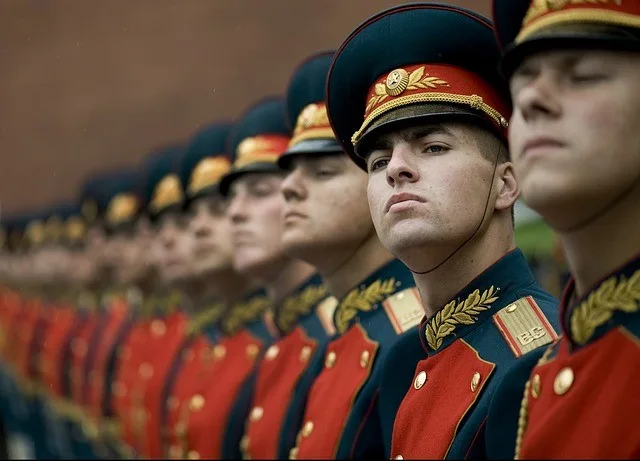
Standardization during the Napoleonic Era
The Napoleonic era in the 19th century saw significant changes in military uniforms, particularly for infantry regiments. Napoleon Bonaparte implemented reforms that standardized uniform colors, styles, and insignia. These changes aimed to create a cohesive and disciplined army with distinct colours for each regiment.
Uniforms became more standardized across different regiments and military forces within an army during this period. Soldiers were now easily recognizable by their distinctive military dress which also helped foster a sense of unity among troops. Advancements in manufacturing techniques allowed for mass production of uniforms on a larger scale for the armies.
Influence of Technological Advancements
Technological advancements have played a crucial role in shaping military uniforms throughout history. For instance, the introduction of firearms during the 17th century necessitated changes in infantry clothing design to provide better protection against projectiles. Soldiers in regiments began wearing metal breastplates and helmets to deflect bullets or other projectiles that could cause harm to armies.
One notable development in the 19th century was the introduction of steel helmets for infantry regiments. These helmets offered increased head protection and became a standard part of military uniforms for armies during World War I. The practicality and effectiveness of steel helmets led to their continued use in subsequent conflicts, including World War II. The steel helmets became an essential piece of clothing for soldiers.
Societal Changes and Symbolism
Military uniforms, worn by armies and their regiments, have also been influenced by societal changes and symbolism. As societies evolved, so did the perception of military forces and their role within society. Uniforms began to reflect national identity, cultural heritage, and even political ideologies, including clothing choices.
For instance, during the 20th century, many countries, including the Indian Army, incorporated national symbols or emblems onto their military uniforms. These symbols served as a source of pride for soldiers in regiments and armies and helped foster a sense of patriotism among troops. Military uniforms often featured rank insignia to establish hierarchy within the armed forces during times of war.
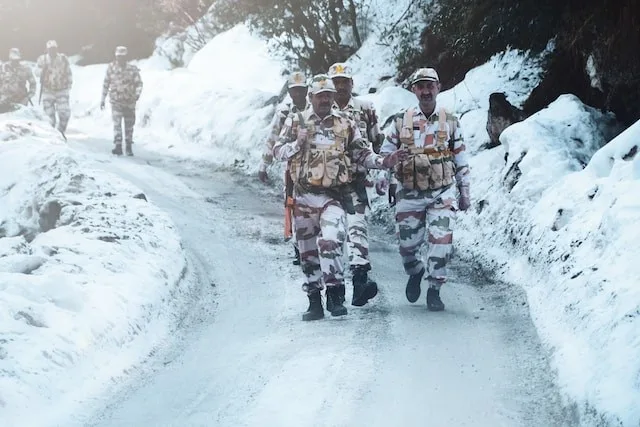
Indian Army Uniform: A Symbol of Honor and Valor
The Indian Army uniform, including military dress and coloured uniforms, is not just a piece of clothing; it is a powerful symbol that reflects the rich heritage and diversity of India. Each branch within the Indian Army, including armies and regiments, has its distinctive uniform, adorned with unique insignia and badges, representing their specific roles and responsibilities.
Iconic Colors in Indian Army Uniforms and Their Meanings
Understanding the Indian Army Uniform Color Palette:
The blue colors used in the Indian Army uniforms hold deep significance for the regiments and armies. They are carefully chosen to convey various meanings and evoke a sense of pride and honor. Let’s explore some of these iconic blue colors.
- Khaki: The most recognizable color in the Indian Army uniform is khaki. It represents discipline, resilience, and endurance. This earthy tone blends well with different terrains, making it an ideal choice for soldiers serving in diverse landscapes across the country. Coloured uniforms have been a long-standing tradition in armies worldwide, with different colours representing different regiments.
- Olive Green: Another prominent color seen in the Indian Army uniform is olive green. This shade symbolizes harmony with nature, camouflage, and adaptability to combat situations. It helps soldiers blend into their surroundings during operations while maintaining a strong presence among blue and red armies and regiments.
Significance of the Indian Army Black Uniform:
In addition to khaki, olive green, black, blue, and red also hold great importance in the Indian Army uniform. The blue and red uniforms are worn by officers who lead armies and regiments into battle or oversee critical operations. These uniforms command respect and inspire confidence among soldiers, signifying authority, power, and determination.
Apart from these primary colors, various other hues can be found in different branches of the Indian Army, such as navy blue for air force personnel or maroon for paratroopers. In addition, each combat uniform worn by different armies and regiments may feature distinct shades of red.
The incorporation of traditional headgear like turbans or berets further adds to the uniqueness of the Indian Army uniform. These headgears not only serve functional purposes but also represent cultural diversity within India’s armed forces. Regiments, armies, officers, and soldiers all wear these headgears.
The overall design of the Indian Army uniforms showcases meticulous attention to detail. The red dress uniforms of the officers and regiments feature rank insignia, badges, and patches that help identify their roles and achievements. These visual representations reflect their dedication, experience, and expertise.
The Indian Army uniform, worn by regiments and officers, stands as a symbol of discipline, bravery, and national pride. It unifies soldiers from diverse backgrounds under one common identity, instilling a sense of camaraderie and shared purpose. The dress is typically blue.
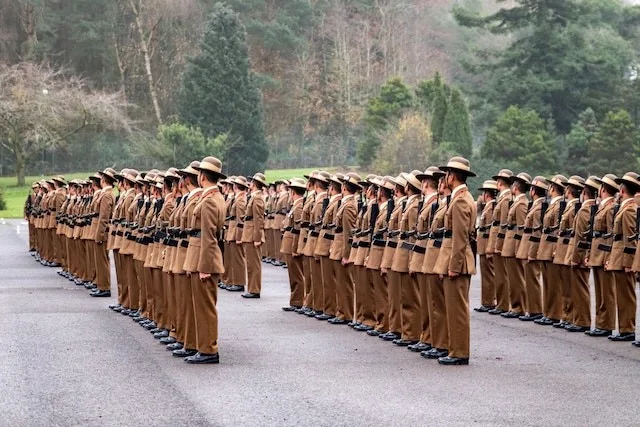
Military Dress Uniforms: Formal Attire for Ceremonial Occasions
Full Dress Uniforms: Regal and Impeccable
Full-dress uniforms worn by officers in the Indian Army are the epitome of regality and impeccable style. These uniforms, which have been worn for over a century, are steeped in tradition and carry a rich historical context that adds to their allure. The vibrant red color of these uniforms further enhances their visual impact.
- Full-dress uniforms of the Indian Army officers are designed with traditional elements that pay homage to the history and heritage of the armed forces. They often feature ornate designs, intricate embroidery, and red embellishments that showcase the military’s proud legacy. From elaborate braiding on the sleeves to gold buttons adorning the coat, every detail is meticulously crafted to reflect the century-old traditions.
These uniforms harken back to a time when military prowess was celebrated through grand displays of pageantry. The historical significance of these garments evokes a sense of honor and respect for the officers of the Indian Army who have served before us. Donning a full-dress uniform is not only an act of pride but also a way to connect with the red past and honor those who came before in the 21st century.
- Present-Day Usage and Occasions: While full-dress uniforms may have originated from times gone by, they still hold immense importance in modern-day military ceremonies and formal events, particularly for officers in the Indian Army. These occasions include parades, change-of-command ceremonies, state visits, funerals, or any official function where utmost respect is required. The significance of these uniforms has endured over the centuries and is symbolized by their iconic blue color.
The wearing of full-dress uniforms by officers in the Indian Army during these events serves as a visual representation of the discipline, professionalism, and dedication exhibited by members of the armed forces. It signifies a commitment to upholding traditions while honoring the sacrifices made by those who serve in the past.
Dress Uniform Colors: Symbolism and Uniformity Across Armed Forces
Military uniform colors, such as blue, hold great significance in the Indian Army. These uniforms are worn by officers and are known as dress uniforms. They symbolize various aspects within the branch. Let’s explore two notable examples.
- The Blue Color Uniform of the Indian Army: Significance and Pride for Officers in the 21st Century The blue color uniform worn by the Indian Army officers holds deep significance and represents the pride associated with serving in this esteemed force. It is a symbol of valor, courage, and dedication to protecting the nation’s sovereignty.
The vibrant shade of blue dress stands out among other military uniforms of the 21st century, making it instantly recognizable. This distinctive color choice embodies the spirit of the Indian Army and instills a sense of national pride in both soldiers and civilians alike.
- The olive green army uniform, with its earthy tones, has become synonymous with functionality and camouflage. Its effectiveness lies in blending seamlessly with natural surroundings, providing effective concealment during combat situations or field operations. This century-old dress continues to serve its purpose on the battlefield.
The blue uniforms of the Indian Army have been a staple for over a century. This practical color choice allows soldiers to merge into their environment, making it harder for adversaries to spot them. The blue dress uniform not only serves as a protective measure but also represents the adaptability and resourcefulness required in military service.
Dress uniforms are worn during formal events such as parades, ceremonies, or official functions.
In the 21st century, dress uniforms take center stage. These occasions in the 21st-century call for an elevated level of decorum, where every detail in the 21st century matters.
Dress uniforms are meticulously tailored to reflect precision and attention to detail. They often feature distinct elements such as medals, ribbons denoting achievements or commendations, ceremonial swords carried by officers, and other insignia that signify rank or affiliation.
Modern Military Uniforms: Functionality and Adaptability
Prioritizing Functionality in Contemporary Warfare
Modern military uniforms, such as the dress uniform, have undergone significant advancements to cater to the demands of contemporary warfare. Unlike their predecessors, these dress uniforms are designed with a primary focus on functionality. Service members rely on their dress uniforms to provide them with the necessary tools and protection required for combat situations.
One key aspect of modern military uniforms is the construction materials used in their dress. These dress materials offer durability, flexibility, comfort, and protection against various environmental conditions. The army combat uniform (ACU), for example, is crafted from a blend of cotton and nylon fabric that strikes a balance between breathability and strength. This combination ensures that service members can withstand rigorous physical training while maintaining optimal comfort during extended periods of dress wear.
Embracing Modern Technology in Military Uniform Design
The evolution of military uniforms, including dress, has also seen a significant integration of modern technology. From moisture-wicking fabrics to advanced camouflage patterns, these innovations enhance the overall functionality of the dress uniform. By incorporating technology into design elements, military forces can adapt more effectively to changing battlefield conditions.
Camouflage patterns play a crucial role in modern military uniforms, especially in dress code, as they aid in concealment on the battlefield. These dress patterns are carefully designed to blend seamlessly with different terrains, providing service members with an added advantage by making them less visible to enemies. Whether it’s woodland or desert environments, camouflage dress allows troops to operate covertly while maintaining strategic positions.
Furthermore, modern military uniforms often incorporate features such as modular attachments and pockets specifically designed for carrying essential equipment. This adaptability enables service members to customize their gear according to mission requirements, ensuring they have quick access to vital tools when needed.
Adherence to Uniform Regulations and Physical Training
While functionality is paramount in modern military uniform design, adherence to uniform regulations remains crucial within armed forces worldwide, including the Indian Army. Uniform regulations ensure consistency across units and help maintain discipline among service members who wear Indian Army uniforms.
Uniformity not only fosters a sense of identity and belonging within the Indian Army but also serves practical purposes for service members who wear Indian Army uniforms. It allows for easy identification of Indian Army dress on the battlefield, promoting cohesion and effective communication. Moreover, uniform regulations help maintain a professional appearance for Indian Army uniforms, instilling a sense of pride among service members and projecting a strong image to adversaries.
Physical training is an integral part of military life, and military uniforms must accommodate the rigorous demands placed on service members’ bodies. Modern military uniforms are designed with considerations for fit, allowing for freedom of movement during physical activities such as running, climbing, and combat maneuvers. The incorporation of stretch fabrics and ergonomic designs ensures that the dress uniforms do not hinder mobility or cause discomfort during intense training sessions.
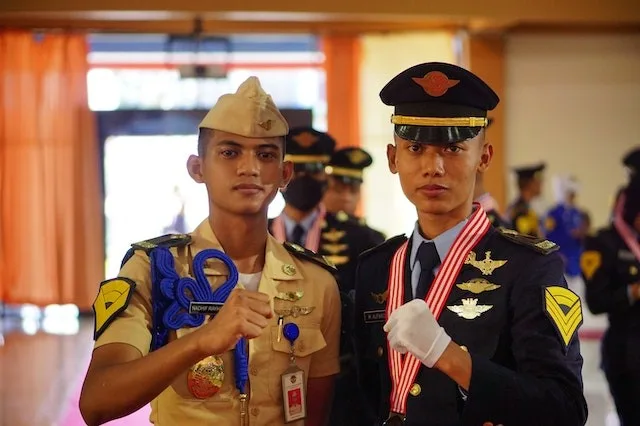
Characteristics of Military Uniforms across Branches
Army Uniforms: Durability and Practicality for Combat Situations
Each branch has its own distinctive dress design that serves to differentiate their roles and responsibilities. The Army is known for its practical and durable uniforms, including the iconic Army Service Uniform (ASU), worn during formal occasions and ceremonies. This dress consists of a dark blue coat with gold buttons, matching trousers or skirt, and a variety of accessories such as shoulder boards indicating rank.
In addition to the Army Service Uniform (ASU), soldiers also wear the Army Green Service Uniform (AGSU), which is currently being reintroduced after being phased out in 2010. The AGSU features a modernized version of the classic World War II-era “pinks and greens” dress. It includes a green dress jacket with pleated pockets, high-waisted dress trousers or skirts, brown leather dress shoes or boots, and various insignia denoting rank and achievements.
However, when soldiers in the Indian Army are deployed in combat zones or training exercises, they don the Operational Camouflage Pattern (OCP) uniform. The OCP uniform provides effective camouflage in various environments while maintaining durability. It features a patterned shirt and pants along with Velcro patches for attaching unit insignia and name tapes. The Indian Army uniforms are an essential part of their dress code.
Get to know details about Army Combat Uniform in my blog titled “Dressed for Glory: Unraveling the Secrets of Army Combat Uniform” which will cover in detail ASU, AGSU, and OCP.
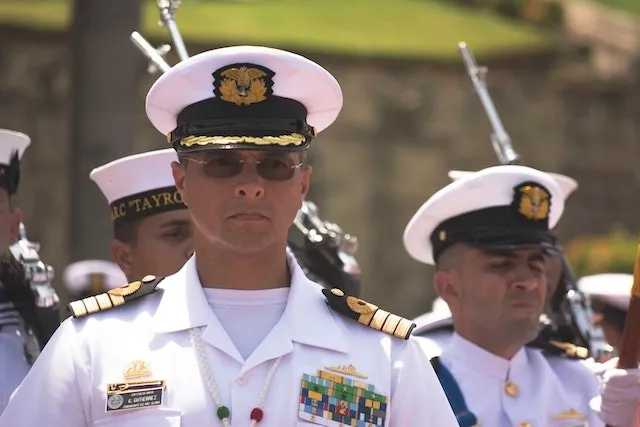
Navy Uniforms: Maritime Traditions Reflected
The Navy’s dress uniforms incorporate elements that reflect their rich maritime traditions. Sailors are often recognized by their distinct white sailor collars adorned with navy blue trimmings—a feature that sets them apart from other branches. These dress collars not only add a touch of tradition but also serve as an identifier for sailors on board ships.
Another notable aspect of Navy uniforms is the use of anchor motifs. Anchors can be found on various parts of their dress such as buttons, belt buckles, and even embroidered on hats. These symbols pay homage to the Navy’s connection to the sea and its role in protecting maritime interests.
Navy personnel also wear different uniforms depending on their specific duties. For example, officers may wear a combination dress cover, which is a distinctive white hat with a gold braid for formal occasions. Enlisted sailors, on the other hand, typically wear a combination of blue dress shirts and trousers known as the Working Dress Uniform or coveralls for more practical tasks.
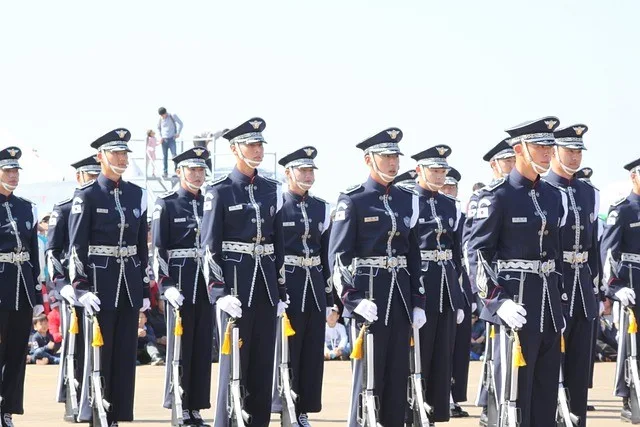
Air Force Uniforms: Functionality in Flight Operations
The Indian Air Force places great emphasis on functionality in their uniform design, particularly due to the unique nature of flight operations. Pilots require specialized Indian Army uniforms that allow them to perform their duties effectively while maintaining a professional appearance.
One of the key components of an Air Force pilot’s uniform is the flight suit. This one-piece garment provides comfort and ease of movement during long hours spent in aircraft cockpits. The flight suit, similar to Indian Army uniforms, often features multiple pockets for storing essential items such as maps, communication devices, and survival equipment.
In addition to flight suits, Air Force personnel also wear service dress uniforms for formal occasions. These uniforms consist of a dark blue coat with silver buttons, matching trousers or skirts, and various insignia denoting rank and achievements.
Overview of Worldwide Military Uniforms
Military uniforms, including the dress, vary worldwide due to cultural, historical, and geographical factors. Each country’s military uniform reflects its unique traditions, values, and identity. Some countries have specific regulations regarding the use of traditional attire within their military dress. The color schemes and patterns used in military uniforms can also be influenced by regional environments.
Cultural Significance of Military Uniforms
Military uniforms, such as the iconic red coats of the British Army, hold immense cultural significance as they symbolize a nation’s dress history and heritage. These uniforms pay homage to important events or figures from the past and are a symbol of their rich military tradition.
In contrast, other countries may choose colors or patterns that represent their national identity or blend with their surroundings. The camouflage patterns seen in many modern military uniforms serve both practical and symbolic purposes, especially when it comes to dressing soldiers for various terrains. These patterns help soldiers blend into their surroundings while also signifying unity and solidarity within the armed forces.
Historical Influences on Military Uniforms
Historical events have played a significant role in shaping military uniforms across different nations. For instance, Germany’s World War II-era uniforms, including the distinctively recognized dress, are characterized by their gray-green color scheme and design features such as peaked caps and jackboots.
Similarly, Japan’s Imperial Army during World War II was known for its distinctive olive green dress uniform with stand-up collars and puttees wrapped around the lower legs. These historical influences not only contribute to the uniqueness of each country’s military dress uniform but also serve as reminders of past conflicts or achievements.
Traditional Attire Regulations
Many countries have regulations governing the inclusion of traditional dress within their military uniforms. These regulations aim to preserve cultural heritage while maintaining a cohesive appearance for the armed forces. In some cases, traditional garments are worn during ceremonial occasions or parades to showcase national pride.
For example, India’s armed forces incorporate elements from various regional cultures into their uniforms. The Border Security Force dons dress turbans and waistcoats, reflecting the attire of the desert regions they patrol. Similarly, the Gurkha soldiers from Nepal serving in the British Army wear traditional kukri knives as part of their ceremonial dress uniform.
Environmental Considerations
The color schemes and patterns used in military uniforms, including dress uniforms, are often influenced by regional environments. Camouflage patterns, specifically designed for soldiers to blend into specific terrains such as forests, deserts, or snowy landscapes, ensure effective operations while minimizing visibility to potential adversaries.
For instance, the United States Marine Corps employs a variety of camouflage patterns tailored for different environments, including woodland camouflage for forested areas, desert camouflage for arid regions, and digital camouflage for urban environments. These adaptations allow military personnel in the army uniforms to remain concealed and maintain a tactical advantage in diverse settings, such as the army service uniform and the army green service uniform.
Unique Aspects of Military Uniforms in Different Countries
British Military Uniforms: A Riot of Color and Tradition
The British regiments take the cake with their vibrant and distinctive dress features. One cannot help but be captivated by the sight of the guards at Buckingham Palace, resplendent in their iconic red dress coats and tall bearskin hats. These colored dress uniforms have become synonymous with the British military and are steeped in history.
The scarlet hue of these military uniforms, known as the dress, has a rich symbolism. It dates back to the 17th century when red dye was readily available and affordable, making it an ideal choice for military attire. The bright color served multiple purposes – it made soldiers more visible on the battlefield, instilled fear in enemies, and helped identify troops amidst the chaos. Over time, this tradition has evolved into a symbol of honor and pride for British regiments.
In addition to their eye-catching red coats, another notable feature of the Guardsmen’s army service uniform is the tall bearskin hat. These towering headpieces, made from real bear fur, require meticulous care to maintain their shape and luster. They serve both ceremonial and practical purposes, providing protection from inclement weather while adding an air of grandeur to formal events.
French Foreign Legion: Embracing Distinctive Accessories
Moving across the English Channel to France, we encounter yet another fascinating aspect of military uniforms – those worn by members of the French Foreign Legion. This renowned fighting force is instantly recognizable thanks to its white dress kepi headgear and blue sash worn diagonally across their chests.
The white kepi is a traditional hat that originated in North Africa during French colonial rule. Its design has remained largely unchanged since then, serving as a symbol of identity for legionnaires around the world. The kepi not only provides shade from scorching sun rays but also distinguishes them from other branches within the French military, such as the dress uniform, army service uniform, and army green service uniform.
Another distinct feature of the French Foreign Legion’s uniform is the blue dress sash. Worn slantwise across their chests, it adds a touch of elegance and prestige to their appearance. This sash has historical significance, harking back to the time when legionnaires would use it as an improvised tourniquet during combat or to carry wounded comrades in a dress.
Russian Army: Blending Tradition with Practicality
In Russia, military uniforms seamlessly blend tradition with practicality, including the iconic fur hat, known as the ushanka. The country’s harsh winters necessitate unique features in their dress, making the ushanka synonymous with Russian winter wear.
The ushanka is a great addition to the dress uniform or service uniform. It offers excellent insulation against freezing temperatures with its thick fur lining and adjustable ear flaps. This distinctive headgear not only protects soldiers from frostbite but also adds a touch of distinctiveness to their appearance.
Russian military uniforms often incorporate other traditional elements as well. For example, the parade dress uniform for officers features braided cords and golden epaulets, exuding an air of grandeur and authority. These regal embellishments pay homage to Russia’s rich history and its reverence for military traditions.
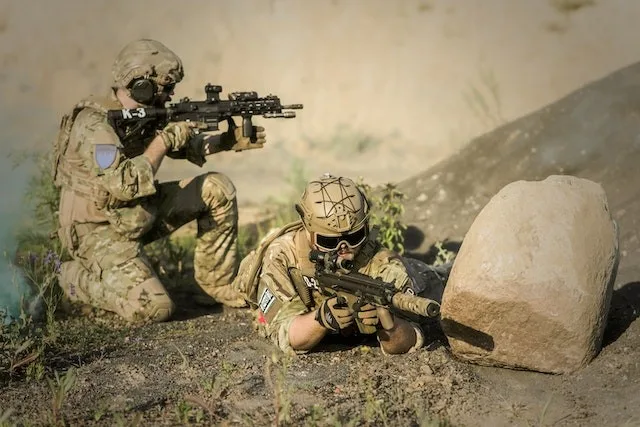
Exploring Camouflage Patterns in Military Uniforms
Camouflage patterns play a crucial role in military attire, aiding soldiers in blending seamlessly into various terrains and environments. These dress patterns are carefully designed to provide effective concealment and enhance the safety of our brave men and women in uniform. Let’s delve deeper into the fascinating world of camouflage patterns used in military dress.
Different Terrain, Different Camouflage
One size certainly does not fit all when it comes to choosing the right camouflage pattern for soldiers’ dress uniforms and service uniforms. The choice depends on the specific terrain where they will be deployed, whether it’s woodland, desert, or urban environments. Each environment demands its own unique blend of colors and shapes to ensure optimal concealment.
In woodland areas characterized by lush greenery and dense foliage, soldiers often wear combat uniforms that feature intricate dress patterns incorporating shades of green, brown, and black. These dress designs mimic the natural surroundings, allowing soldiers to merge effortlessly with their environment. Accessories like patrol caps may also sport these woodland-inspired dress hues for complete camouflage.
On the other hand, desert landscapes necessitate different color schemes to shield troops from prying eyes under the scorching sun. Desert combat uniforms usually exhibit sandy tones such as beige or tan mixed with light browns or pale greens. This combination helps soldiers blend into arid regions where vegetation is sparse. The dress worn by soldiers in desert combat is specifically designed to camouflage them in sandy environments.
For urban warfare scenarios where concrete jungles dominate the landscape, camouflage dress patterns take on a different approach altogether. Rather than mimicking natural elements, these dress designs focus on breaking up human silhouettes against man-made structures like buildings and vehicles. Shades of gray and blue are commonly employed for urban combat dress uniforms to aid soldiers in remaining inconspicuous amidst bustling cityscapes.
Advancements in Camouflage Technology
As technology has advanced over time, so too has the science behind camouflage patterns for military personnel. Traditional analog designs have given way to digital patterns that offer enhanced concealment capabilities for those wearing the dress uniform.
Digital camouflage employs pixelated arrangements to create a more seamless blend with the surrounding environment, making it challenging for adversaries to detect soldiers. These patterns utilize small rectangular pixels in different colors, resulting in a visually disruptive effect. The United States Marine Corps has adopted the MARPAT (Marine Pattern) camouflage uniform, featuring pixelated designs in woodland and desert variants. This dress is highly effective in concealing soldiers.
Furthermore, some countries have developed specialized camouflage patterns tailored to their specific operational needs. The British Army’s Multi-Terrain Pattern (MTP) dress uniform is designed to be effective across various environments, combining elements from both woodland and desert patterns. Similarly, the German Armed Forces employ the Flecktarn dress pattern, characterized by small splinter-like shapes that provide excellent concealment in forested areas.
Colors and Patterns: More Than Meets the Eye
While most people associate camouflage with earthy tones like greens and browns, military uniforms can incorporate a wide range of colors depending on the intended purpose and environment. The dress of military personnel can vary greatly in color and pattern.
In certain circumstances, bright colors may be strategically used as part of a soldier’s combat attire, such as the red dress trousers worn by British ceremonial troops. These vibrant garments serve as an emblematic display of tradition and honor during formal events, symbolizing historical significance rather than concealment.
Similarly, naval forces often dress in blue uniforms instead of traditional camouflage patterns.
Conclusion
After exploring the various aspects of military uniforms, it is clear that they hold immense historical and cultural significance. Military uniforms, including dress uniforms, have evolved over time, reflecting changes in warfare strategies, technology, and societal norms.
From the Indian Army’s uniform symbolizing honor and valor to formal dress uniforms worn during ceremonial occasions, each type of military uniform serves a unique purpose. These uniforms not only portray professionalism but also instill a sense of pride and unity among military personnel.
In the modern era, designing military uniforms that provide comfort, protection, and ease of movement while meeting the specific requirements of different branches of the armed forces is crucial. Functionality and adaptability are key factors in creating these uniforms, ensuring that soldiers can perform their duties effectively. The dress plays a significant role in achieving these objectives.
Military uniforms, including dress uniforms, vary across countries and showcase distinctive characteristics that reflect national identity and traditions. Each country has its own unique aspects when it comes to military dress.
One fascinating aspect is the use of camouflage patterns in military uniforms. These dress patterns are designed to blend with different environments, providing soldiers with an advantage on the battlefield. The development and implementation of camouflage techniques have revolutionized modern warfare.
To summarize, military uniforms, including dress uniforms, play a vital role in representing national pride, discipline, and unity among armed forces worldwide. They have evolved over time to meet changing needs while still upholding tradition and symbolism.
In conclusion, understanding the types of military uniforms allows us to appreciate their historical significance and functional importance in the world of military attire. Whether you’re a history enthusiast, someone interested in fashion design, or considering joining the armed forces yourself, exploring this topic provides valuable insights into the dress of military personnel.
And if, by chance, you would like to build a project on uniforms, do let me have your thoughts on my email, [email protected], and we could build a lovely relationship. And lastly, before we sign out, if you want to gain more knowledge in uniforms, you may check my other blog about the types of uniforms in various industries.
FAQs
Are all military uniforms made from similar materials?
Military uniforms, including dress uniforms, are made from various materials depending on their purpose and climate conditions. While some may be made from durable fabrics like cotton or polyester blends for everyday wear, others might incorporate specialized materials such as flame-resistant fibers for combat situations.
Do different branches within a country’s armed forces wear distinct uniforms?
Yes, different branches within a country’s armed forces often have their own unique dress uniforms. These variations help distinguish between the army, navy, air force, and other divisions. The colors, insignias, and design elements of the dress may differ to reflect the specific roles and responsibilities of each branch.
How long does it take to design a new military uniform?
The process of designing a new military dress uniform can vary depending on several factors. It involves extensive research, prototyping, testing for functionality and durability of the dress, as well as considering input from military personnel who will wear the dress. This process can take several months or even years to ensure that the final dress meets all requirements.
Are military uniforms only worn during combat situations?
While military uniforms are primarily associated with combat situations, they are also worn during various non-combat activities such as parades, ceremonies, official events, and daily duties on military bases. The dress uniforms serve as a visual representation of discipline and professionalism in both combat and non-combat settings.
Can civilians purchase authentic military uniforms?
Authentic military uniforms are typically not available for purchase by civilians due to security concerns and regulations. However, there are replica versions or similar civilian clothing inspired by military dress designs that can be found in certain stores or online retailers. It is important to respect the significance of these uniforms when wearing them outside of their intended dress context.
Which army wears Blue uniform in India
The Indian Air Force’s formal dress uniform, known as the “No. 1 Dress,” features a blue tunic and trousers, similar to the Indian Army’s ceremonial attire. This uniform is worn during formal events, parades, and special occasions by the members of the Indian Air Force.



Pingback: Stand Out With Style: Embrace Diversity Of Types Of Uniforms
Pingback: Dressed For Glory: Unraveling Secrets Of Army Combat Uniform